If there was any kind of recurring theme to my trip, it would be "art". Indeed, I chose Paris and Rome because of, among many other reasons, Louvre and Vatican Museum, respectively, which are two of the greatest art museums in the world. However, they are so large that you can hardly see everything for a single visit.
That is one of the reasons I like middle-sized museums, especially MoMA, Orsay and Uffizi. While MoMA is famous for Modern Art and Orsay, for French Impressionism, Galleria degli Uffizi is the best place for my favorite, Italian Renaissance. (By the way, Firenze used to have a very nice Chinese name, "翡冷翠". After the Anglicization of Modern Chinese, it is now called "佛罗伦萨", the transliteration of "Florence".)
However, Uffizi imposes a strict "no camera" policy so not a single photo I can show you. (Don't get me wrong: I think it IS good for the preservation of art.) I could only tell you that I was overwhelmed. So many paintings I had longed for were right in front of my eyes: Botticelli's beautiful "The Birth of Venus", freaky "Primavera" and Titian's voluptuous "Venus of Urbino" are crowd-pleasers, among many others. (Guess which one I brought home on a magnet?) For the number of paintings and sculptures on display, Uffizi seemed a little cozy, just like Firenze, or the whole Italy, where masterpieces stand side by side, giving you no chance of catching your breath.
I reserved two days for Firenze partly because I knew I was going to spend one day for museums and one for the rest. Another reason was that most museums were closed on Monday. So it made perfect sense for me to walk around on my first day, which happened to be Monday. When I was researching Firenze, I noticed that people recommended a walking tour. I decided to give it a shot.
The tour was ok, probably because I knew way too much about Firenze than an average tourist. To be fair, our guide did a great job in leading the walk and explaining the sites in English, with a little Italian flavor. However, I couldn't spend as much time as I wanted for each place so after it was finished, I kind of did the whole tour again by myself.
But before I show you the pictures, I would like to tell you two things that made Firenze unique in my whole journey. First, my hostel in Firenze, Ostello Gallo D'Oro, was the best hostel I've ever stayed. What earned it a five-star rating was the extremely friendly staff/owners, Max and Silvia. They made you feel like home. The room was spacious and the beds were very clean. The only thing that wasn't perfect was its location. But after you read your map for a while, it wasn't that hard to get to after all. Max was a happy Italian who would greet you in a "rise-and-shine" spirit in the morning and offer you great help in touring the city. He enjoyed being a hostel owner and took great care of it. I enjoyed my stay so well that I wrote them a postcard to express my gratitude.
Secondly, I had the best meal of my whole trip in Firenze with two fellow hostelers, Ryan, a San Francisco chef who worked in a Italian restaurant owned by Giorgio Armani, and Matt, a book publisher who was searching for a more exciting career by means of traveling. Naturally it was Ryan who got to decide where to go. And he took out his Lonely Planet travel book and located a place which specializes in a dish with an unusual part of an ox. (Being Chinese, I have no problem eating virtually everything that can be eaten. Bring it on, Italy!)
Like all good places, it had a humble outlook, which sometimes made it hard to find. Once you went inside, you would be greeted by a very traditional oven, and several friendly Italian staff who were making pizza in it. They welcomed us with cute Italian-accented English and we had some nice small talks, things like "Where have you been?", "What have you seen?" and "Who's the best? Michelangelo!"
Here comes an important dining tip. The usher offered us an empty table in the room but Ryan (or Matt?) insisted on a table in the courtyard. "What courtyard?" I wondered. One of the waiters hesitated but eventually one of them agreed. So we walked a long way into the restaurant, across all the usual seats and all of the sudden, a nice open courtyard magically appeared.
Then we ordered the interesting dish as planned. Of course, some nice Italian wine and salad, too. The food was deliciously, especially with good companies. We found out that we were about the same age, that is, older than a usual European or Australian hosteler. We shared travel experience and the differences between life in Europe and in the States. And the best part was that the meal didn't cost us a fortune. What a great time!
That were the stories I couldn't tell with my camera. Now for the pictures. Again, they were taken at very different times of the day, which was evident if you pay attention to the lighting. I rearranged them as I saw fit.
Our tour started with two sculptures by Donatello, one of the best sculptors in Renaissance Italy.
Our guide asked us who the statue was. Having just come from Venezia, I had no problem identifying him. Then our guide told us an anecdote about the ignorant commissioner who didn't like Donatello's work first because he made appropriate adjustments for the final installation by elongating the face and exaggerating the pose. Donatello promised to rebuilt it to the commissioner's liking but did nothing, of course. After the final installation, the commissioner liked it very much and Donatello asked for more money for "extra" work. A typical folklore. Our tour guide kept on telling stories like this to make it interesting. I didn't really need them. But again, I was not a "typical" tourist, either.
In Firenze, you can't miss Medici family, the powerful "Grand Duke of Tuscany" and contributor of several popes! That's why you see Medici properties everywhere.
Big families like Medici were in banking business and these were the parking places outside of the bank.
A corner of the building.
The Six Bolts are the prominent symbol of the Medici family. Again, you can find it virtually everywhere.
Piazza della Repubblica was the place where the tour started and ended.
Palazzo Vecchio was this castle like city hall. The best of Firenze was literally just around the corner.
No other person than Michelangelo makes Firenze prouder. His masterpiece, "David", stands right in front of the entrance of the Palazzo, as it has been hundreds of years before. Although the one you see here is not the original, it was a fine replica. For protection, the original was moved to Galleria dell'Accademia, which I visited the next day.
The "perfect penis" of David was constantly mocked by wacky souvenirs.
Make sure that you walk around the statue to see it from different angles so that you would fully appreciate how much effort the sculptor puts in it.
I took some liberty to compose my pictures slightly differently.
How could I leave here without a picture of David and me together? Thanks to a very friendly Asian!
At the right of the Palazzo was the Uffizi, which needs admission to get in. In front of the Palazzo was the amazing sculpture garden, or Loggia dei Lanzi, which is free.
Unlike the "David", all these sculptures were originals. I couldn't stop walking around them, as if they would suddenly start moving.
Now let me show you some of my favorites. This is "Perseus holding the head of Medusa" by Cellini.
From a different angle.
"The Rape of Polyxena" depicts a striking moment when a Roman soldier forcefully took the young Polyxena away.
Look how many human bodies there are in this single work.
This is an exaggerated battle scene.
An elegant Greek woman.
This bizarre-looking sculpture, which puts three persons one over another, was the fruit of a free composition. The story went like that a big marble was given to the artist, who was told to make whatever he liked. In a proud display of incredible skills, he made "The Rape of the Sabine Women".
From a different angle.
It really shows you how different a sculpture is from a painting.
You have to look around to get a full sense of the composition.
On the right of the Palazzo was the Piazza della Signoria. More amazing statues.
The Neptune was in the center of a fountain. It was said that the major of Firenze at that time actually posed as a model. The Lion was holding a symbol of the city.
Firenze is unique in that the city is mixed with Roman, medieval and Renaissance architecture. The pretty building at the corner should be a Renaissance church.
This was a medieval prison-turned posh hotel. Note that the unaligned windows were an (ugly) feature of medieval architecture.
Whereas the Palazzo Vecchio was the center of secular affairs, the Duomo was the center of spiritual engagements. The Duom di Firenze was the second largest cathedral in the world. Like all great churches, it took hundreds of years to build. It was said that the size of the dome was too large for any engineer to finish. However, that did not worry the Florentines, who believed that someone who could do the job would eventually be born into this world. And he was.
The campanile, or bell tower, looked great.
The full name of the Duomo was "Cattedrale di Santa Maria del Fiore".
Unlike in Milano, where it had an big open space in front of the church, there was little room for a good frontal photo shot, unless you had a helicopter.
The gate was richly decorated, as expected. During the medieval time, great cities of the Latin world competed with each other in church-building.
Stepping inside, you would have a sense how big it was. First, let's raise our head for the engineering wonder of the great dome, on which you could even take a walk.
And the floor was beautifully crafted, too.
The building in front was the San Giovanni Baptistery.
The Baptistery was famous for its two gold-gilded bronze gates. On this gate, scenes from Jesus' life.
After I took my time admiring the Duomo, I started my routine of wandering around.
The market was good for some cheap souvenirs.
I also visited the Palazzo Medici Riccardi, whose exterior I had showed you before. Inside the Palazzo, a typical renaissance courtyard. However, not much to see beyond that. And part of the building was still an active government office, which I bumped into because of the lack of a proper floorplan.
There's no great city without a river. For Firenze, it is the Arno. There's no great river without a bridge. For Arno, it is the Ponte Vecchio.
Known today as the jewelry street of Firenze, the main business of the Ponte used to be, believe it or not, butchery.
Because of the butchery, the bridge used to stink. But it was on the way of a noblewoman's daily church-going. What did she do? She built a private pathway over the bridge! You can see it from this picture, which I took from a hotel nearby. The hotel must be really expensive, having such a great view of the Ponte.
I wandered more.
The joy of wandering was exactly the reward of this kind.
This was a small piazza of which I didn't know the name. There were still too many places worthy visiting in Firenze. I didn't go simply because I didn't have the time. In order to save time, I had booked my ticket to Uffizi in advance (with a huge booking fee!) and it saved me almost two hours. But I didn't do the same for Galleria dell'Accadimia so I did wait in line for more than an hour, under the sun! Well, at least I saved some euros.
That is one of the reasons I like middle-sized museums, especially MoMA, Orsay and Uffizi. While MoMA is famous for Modern Art and Orsay, for French Impressionism, Galleria degli Uffizi is the best place for my favorite, Italian Renaissance. (By the way, Firenze used to have a very nice Chinese name, "翡冷翠". After the Anglicization of Modern Chinese, it is now called "佛罗伦萨", the transliteration of "Florence".)
However, Uffizi imposes a strict "no camera" policy so not a single photo I can show you. (Don't get me wrong: I think it IS good for the preservation of art.) I could only tell you that I was overwhelmed. So many paintings I had longed for were right in front of my eyes: Botticelli's beautiful "The Birth of Venus", freaky "Primavera" and Titian's voluptuous "Venus of Urbino" are crowd-pleasers, among many others. (Guess which one I brought home on a magnet?) For the number of paintings and sculptures on display, Uffizi seemed a little cozy, just like Firenze, or the whole Italy, where masterpieces stand side by side, giving you no chance of catching your breath.
I reserved two days for Firenze partly because I knew I was going to spend one day for museums and one for the rest. Another reason was that most museums were closed on Monday. So it made perfect sense for me to walk around on my first day, which happened to be Monday. When I was researching Firenze, I noticed that people recommended a walking tour. I decided to give it a shot.
The tour was ok, probably because I knew way too much about Firenze than an average tourist. To be fair, our guide did a great job in leading the walk and explaining the sites in English, with a little Italian flavor. However, I couldn't spend as much time as I wanted for each place so after it was finished, I kind of did the whole tour again by myself.
But before I show you the pictures, I would like to tell you two things that made Firenze unique in my whole journey. First, my hostel in Firenze, Ostello Gallo D'Oro, was the best hostel I've ever stayed. What earned it a five-star rating was the extremely friendly staff/owners, Max and Silvia. They made you feel like home. The room was spacious and the beds were very clean. The only thing that wasn't perfect was its location. But after you read your map for a while, it wasn't that hard to get to after all. Max was a happy Italian who would greet you in a "rise-and-shine" spirit in the morning and offer you great help in touring the city. He enjoyed being a hostel owner and took great care of it. I enjoyed my stay so well that I wrote them a postcard to express my gratitude.
Secondly, I had the best meal of my whole trip in Firenze with two fellow hostelers, Ryan, a San Francisco chef who worked in a Italian restaurant owned by Giorgio Armani, and Matt, a book publisher who was searching for a more exciting career by means of traveling. Naturally it was Ryan who got to decide where to go. And he took out his Lonely Planet travel book and located a place which specializes in a dish with an unusual part of an ox. (Being Chinese, I have no problem eating virtually everything that can be eaten. Bring it on, Italy!)
Like all good places, it had a humble outlook, which sometimes made it hard to find. Once you went inside, you would be greeted by a very traditional oven, and several friendly Italian staff who were making pizza in it. They welcomed us with cute Italian-accented English and we had some nice small talks, things like "Where have you been?", "What have you seen?" and "Who's the best? Michelangelo!"
Here comes an important dining tip. The usher offered us an empty table in the room but Ryan (or Matt?) insisted on a table in the courtyard. "What courtyard?" I wondered. One of the waiters hesitated but eventually one of them agreed. So we walked a long way into the restaurant, across all the usual seats and all of the sudden, a nice open courtyard magically appeared.
Then we ordered the interesting dish as planned. Of course, some nice Italian wine and salad, too. The food was deliciously, especially with good companies. We found out that we were about the same age, that is, older than a usual European or Australian hosteler. We shared travel experience and the differences between life in Europe and in the States. And the best part was that the meal didn't cost us a fortune. What a great time!
That were the stories I couldn't tell with my camera. Now for the pictures. Again, they were taken at very different times of the day, which was evident if you pay attention to the lighting. I rearranged them as I saw fit.
Our tour started with two sculptures by Donatello, one of the best sculptors in Renaissance Italy.
Our guide asked us who the statue was. Having just come from Venezia, I had no problem identifying him. Then our guide told us an anecdote about the ignorant commissioner who didn't like Donatello's work first because he made appropriate adjustments for the final installation by elongating the face and exaggerating the pose. Donatello promised to rebuilt it to the commissioner's liking but did nothing, of course. After the final installation, the commissioner liked it very much and Donatello asked for more money for "extra" work. A typical folklore. Our tour guide kept on telling stories like this to make it interesting. I didn't really need them. But again, I was not a "typical" tourist, either.
In Firenze, you can't miss Medici family, the powerful "Grand Duke of Tuscany" and contributor of several popes! That's why you see Medici properties everywhere.
Big families like Medici were in banking business and these were the parking places outside of the bank.
A corner of the building.
The Six Bolts are the prominent symbol of the Medici family. Again, you can find it virtually everywhere.
Piazza della Repubblica was the place where the tour started and ended.
Palazzo Vecchio was this castle like city hall. The best of Firenze was literally just around the corner.
No other person than Michelangelo makes Firenze prouder. His masterpiece, "David", stands right in front of the entrance of the Palazzo, as it has been hundreds of years before. Although the one you see here is not the original, it was a fine replica. For protection, the original was moved to Galleria dell'Accademia, which I visited the next day.
The "perfect penis" of David was constantly mocked by wacky souvenirs.
Make sure that you walk around the statue to see it from different angles so that you would fully appreciate how much effort the sculptor puts in it.
I took some liberty to compose my pictures slightly differently.
How could I leave here without a picture of David and me together? Thanks to a very friendly Asian!
At the right of the Palazzo was the Uffizi, which needs admission to get in. In front of the Palazzo was the amazing sculpture garden, or Loggia dei Lanzi, which is free.
Unlike the "David", all these sculptures were originals. I couldn't stop walking around them, as if they would suddenly start moving.
Now let me show you some of my favorites. This is "Perseus holding the head of Medusa" by Cellini.
From a different angle.
"The Rape of Polyxena" depicts a striking moment when a Roman soldier forcefully took the young Polyxena away.
Look how many human bodies there are in this single work.
This is an exaggerated battle scene.
An elegant Greek woman.
This bizarre-looking sculpture, which puts three persons one over another, was the fruit of a free composition. The story went like that a big marble was given to the artist, who was told to make whatever he liked. In a proud display of incredible skills, he made "The Rape of the Sabine Women".
From a different angle.
It really shows you how different a sculpture is from a painting.
You have to look around to get a full sense of the composition.
On the right of the Palazzo was the Piazza della Signoria. More amazing statues.
The Neptune was in the center of a fountain. It was said that the major of Firenze at that time actually posed as a model. The Lion was holding a symbol of the city.
Firenze is unique in that the city is mixed with Roman, medieval and Renaissance architecture. The pretty building at the corner should be a Renaissance church.
This was a medieval prison-turned posh hotel. Note that the unaligned windows were an (ugly) feature of medieval architecture.
Whereas the Palazzo Vecchio was the center of secular affairs, the Duomo was the center of spiritual engagements. The Duom di Firenze was the second largest cathedral in the world. Like all great churches, it took hundreds of years to build. It was said that the size of the dome was too large for any engineer to finish. However, that did not worry the Florentines, who believed that someone who could do the job would eventually be born into this world. And he was.
The campanile, or bell tower, looked great.
The full name of the Duomo was "Cattedrale di Santa Maria del Fiore".
Unlike in Milano, where it had an big open space in front of the church, there was little room for a good frontal photo shot, unless you had a helicopter.
The gate was richly decorated, as expected. During the medieval time, great cities of the Latin world competed with each other in church-building.
Stepping inside, you would have a sense how big it was. First, let's raise our head for the engineering wonder of the great dome, on which you could even take a walk.
And the floor was beautifully crafted, too.
The building in front was the San Giovanni Baptistery.
The Baptistery was famous for its two gold-gilded bronze gates. On this gate, scenes from Jesus' life.
After I took my time admiring the Duomo, I started my routine of wandering around.
The market was good for some cheap souvenirs.
I also visited the Palazzo Medici Riccardi, whose exterior I had showed you before. Inside the Palazzo, a typical renaissance courtyard. However, not much to see beyond that. And part of the building was still an active government office, which I bumped into because of the lack of a proper floorplan.
There's no great city without a river. For Firenze, it is the Arno. There's no great river without a bridge. For Arno, it is the Ponte Vecchio.
Known today as the jewelry street of Firenze, the main business of the Ponte used to be, believe it or not, butchery.
Because of the butchery, the bridge used to stink. But it was on the way of a noblewoman's daily church-going. What did she do? She built a private pathway over the bridge! You can see it from this picture, which I took from a hotel nearby. The hotel must be really expensive, having such a great view of the Ponte.
I wandered more.
The joy of wandering was exactly the reward of this kind.
This was a small piazza of which I didn't know the name. There were still too many places worthy visiting in Firenze. I didn't go simply because I didn't have the time. In order to save time, I had booked my ticket to Uffizi in advance (with a huge booking fee!) and it saved me almost two hours. But I didn't do the same for Galleria dell'Accadimia so I did wait in line for more than an hour, under the sun! Well, at least I saved some euros.
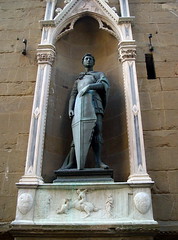
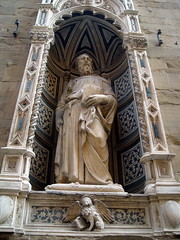
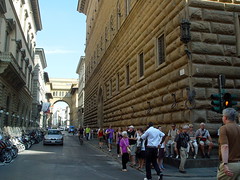
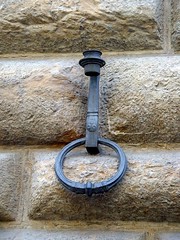
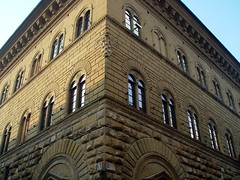

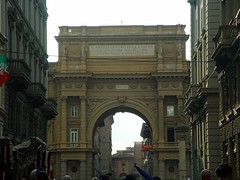

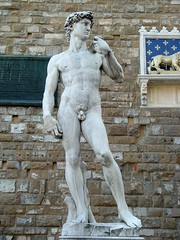
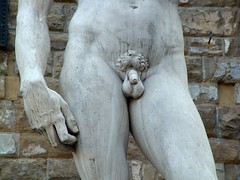
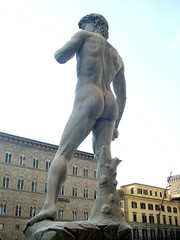
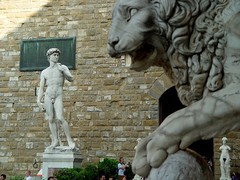
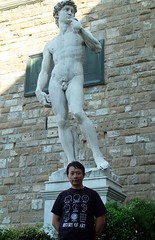
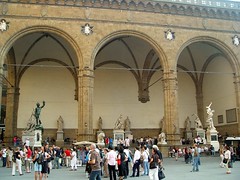
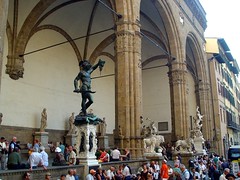
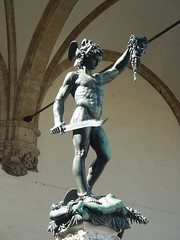
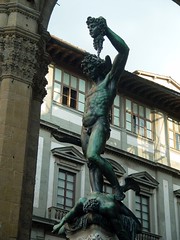


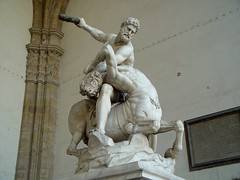
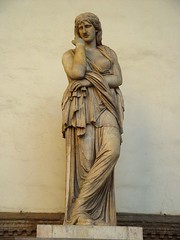
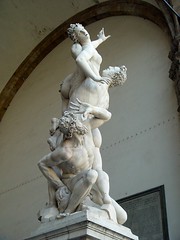

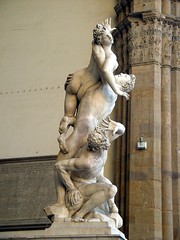
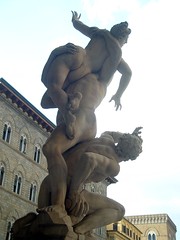

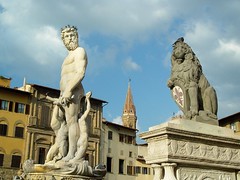
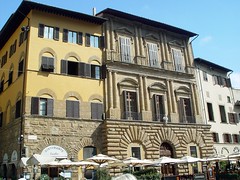


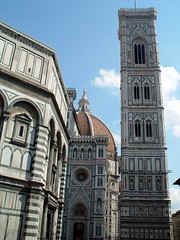



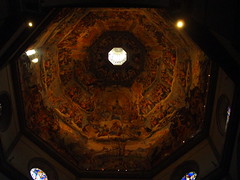
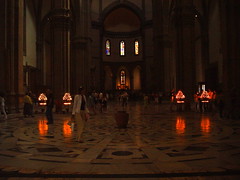

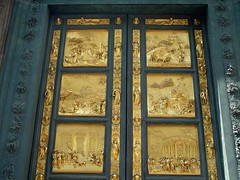
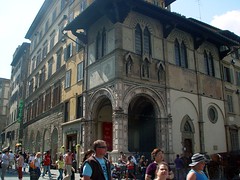
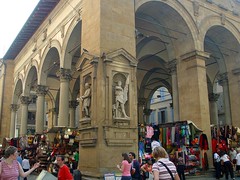

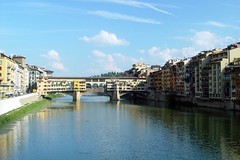
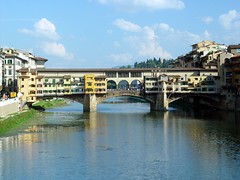
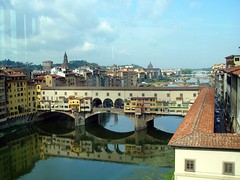
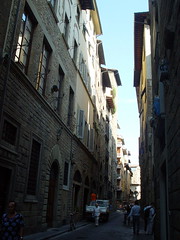
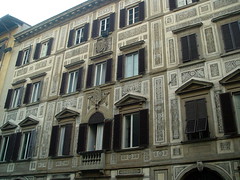

Comments